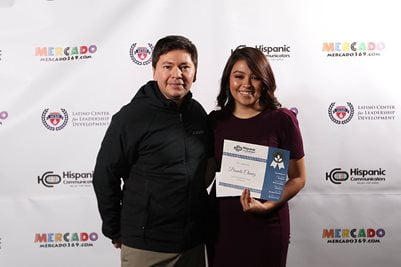A university of distinction for Hispanic students

The University of Texas at Arlington is ranked among the Top 100 Colleges and Universities for Hispanic Students, according to an annual list from The Hispanic Outlook on Education Magazine.
UTA was nationally ranked in three categories:
- No. 5 in architecture degrees
- No. 24 in total graduate degrees
- No. 26 in total enrollment
This is the latest recognition of UTA’s long-standing commitment to diversity and serving Hispanic students. In 2014, UTA became the largest public four-year university in Texas to meet U.S. Department of Education requirements to be labeled a Hispanic-Serving Institution (HSI).
UTA is one of only 14 universities in the nation to achieve designations of both HSI and Carnegie R-1: “Very High Research” in the Carnegie Classification of Institutions of Higher Education.

Michele Bobadilla, assistant provost for Hispanic student success, said UTA is diverse, affordable and provides students with a first-rate education that prepares them for the workforce.
“UTA offers our students world-class, global opportunities, exposure to diverse communities and viewpoints and a prime location within our country’s economic engine marketplace,” said Bobadilla, who is also senior associate vice president for outreach services and community engagement.
The HSI designation allows UTA to access federal funding for initiatives aimed at expanding educational opportunities and increasing degree attainment rates among all students. The UTA I.D.E.A.S. Center, for example, is a hub of services for students transitioning to a four-year university. The center offers free tutoring and mentoring, as well as other programs in coordination with academic success partners.
The University is also part of the United States Hispanic Chamber of Commerce Foundation’s University Partnership Initiative, led by Bobadilla. The initiative’s goal is to build a robust college-to-career pipeline between UTA and the corporations that partner with the Foundation, resulting in enhanced career-readiness for students and an immediately employable talent pool for various industries.
UTA is ranked No. 5 nationally in U.S. News & World Report’s Best Colleges for 2019 diversity index listing and is ranked among the top universities in the country for conferring degrees to minority students by the publication Diverse: Issues in Higher Education, including No. 3 in Texas and No. 18 in the country for master’s degrees awarded to Hispanic graduate students.

“These recognitions validate our efforts to improve education for Hispanic students,” said Julian Rodriguez, broadcast journalism specialist and faculty adviser for the UTA Hispanic Media Initiative. “As a Hispanic-Serving Institution, UTA provides access to academic and professional support services sensitive to the needs of our Latino population.”
Brenda Chavez, soon to be a first-generation college graduate, is one of those students. The broadcast and Spanish interpretation senior attended two other institutions before arriving at UTA. She said the University’s variety of degree programs, location, affordability and commitment to diversity are what led her to become a Maverick.
“I saw a variety of programs and opportunities aimed at Hispanic students,” Chavez said. “While on campus, I was fortunate to meet and interact with people who shared my cultural values and passions. Attending UTA allowed me to feel included and supported, which I believe is key when it comes to academic success.”
Rodriguez said UTA is an ideal choice for Hispanic students.
“I like to encourage prospective students to look around and visit other campuses,” he said. “Not because I don't want them to be part of UTA, but because I want them to realize UTA is the one opportunity they cannot pass.”
Each year The Hispanic Outlook on Education Magazine acknowledges America’s top colleges and universities with the most Hispanic students, as well as schools granting the most degrees to Hispanic students generally and for specific majors. The rankings, published in the August/September issue of the magazine, were determined using data from the National Center for Education Statistics and The Integrated Postsecondary Education Data System.